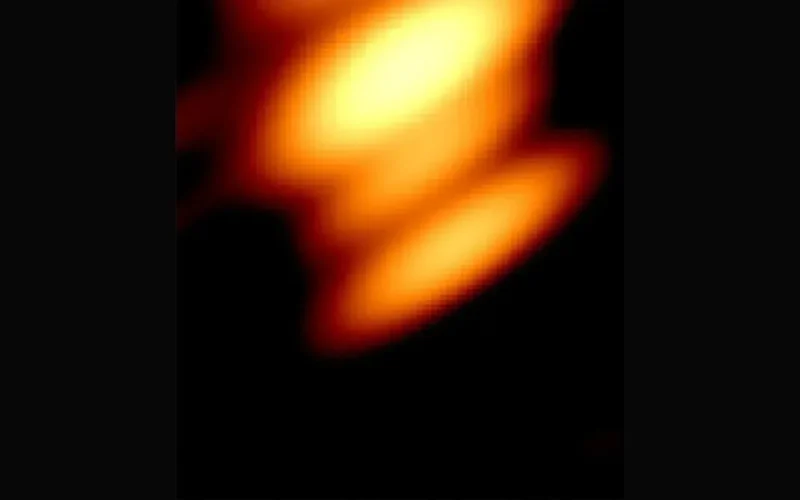
Astronomers have captured a radio image showing two black holes orbiting each other for the first time, just six years after the release of the first-ever photo of a single black hole.
The discovery confirms that pairs of supermassive black holes really do exist — something scientists have suspected for decades but never directly seen until now.
The system lies at the heart of a brilliant space object called quasar OJ 287, about 3.5 billion light-years from Earth. Quasars, a portmanteau for “quasi-stellar objects,” are extremely bright galaxy cores powered by black holes feasting on surrounding gas and dust. OJ 287 has long stood out because its brightness rises and falls every 12 years. That pattern was a clue that two giant black holes might be circling one another like in a cosmic do-si-do.
The new observations are among the sharpest radio images ever made to explore what’s happening deep inside a quasar — and offers evidence that both black holes may be producing their own powerful jets of energy.
“The image of the two black holes was captured with a radio telescope system that included the RadioAstron satellite,” said Mauri Valtonen of the University of Turku in Finland, in a statement. “In recent years, we have only been able to use Earth-based telescopes, where the image resolution is not as good.”
Black holes rank among the most mind-boggling objects in the cosmos. They are regions in space where gravity is so intense that nothing, not even light, can escape. About 50 years ago, astronomers weren’t entirely convinced these invisible giants were even real.
Today, black holes aren’t just accepted, they’re being photographed by a collection of enormous, synced-up radio dishes. In 2019, the Event Horizon Telescope produced the first-ever image of a black hole, located 53 million light-years away in the galaxy Messier 87. Three years later, the same group captured another historic image: the black hole at the center of our own Milky Way, called Sagittarius A*, or Sgr A* for short.
This new history-making radio image is part of a broader OJ 287 study led by Valtonen, which appears in The Astrophysical Journal. The host galaxy is thought to have one enormous black hole — about 18 billion times the weight of the sun — and a smaller companion roughly equal to 150 million suns in mass. As the smaller one orbits, it periodically crashes through the larger black hole’s disk of gas and dust, creating predictable bursts of light.
The first hints that something weird was happening in OJ 287 emerged in the late 1800s, according to the paper, when the quasar appeared unexpectedly in early sky photographs — long before scientists even knew black holes existed.
In the 1980s, Finnish astronomer Aimo Sillanpää noticed its repeating light pattern and proposed the idea of two black holes. Since then, researchers around the world have tracked the system, trying to map out the pair’s motion. More recently, scientists have calculated how they think the pair ought to appear.

Credit: Event Horizon Telescope Collaboration
The confirmation of this duo came from a powerful radio telescope network that included the Russian RadioAstron satellite, which operated until 2019. Its antenna once orbited about 120,000 miles from Earth, about halfway to the moon. When combined with ground-based radio dishes, this setup achieved extremely high resolution.
The approach differed from how the previous images of black holes were made, which used the Event Horizon Telescope, a virtual Earth-sized telescope that links radio dishes around the world. Instead, the new OJ 287 image used a space-based technique that “achieved a much longer observing baseline, and hence a higher-resolution image,” said Daniel Reichart, a University of North Carolina professor and one of the study’s co-authors.
The method has its drawbacks: It uses longer radio wavelengths that blur as they travel through space, making it impossible to see a black hole’s edge. The tradeoff, Reichart explained to Mashable, is that the Event Horizon Telescope “has a slightly lower resolution, but a higher fidelity,” delivering clearer images. But with the space-based technique, the team was able to see enough detail to separate the two black holes within OJ 287. Without that resolution, the pair would otherwise appear as a single light.
“For the first time, we managed to get an image of two black holes circling each other,” Valtonen said. “The black holes themselves are perfectly black, but they can be detected by these particle jets or by the glowing gas surrounding the hole.”
The team also saw something new: a twisting jet from the smaller black hole, which seems to whip back and forth as it moves through its orbit. Future studies may observe the jet changing direction over time.
